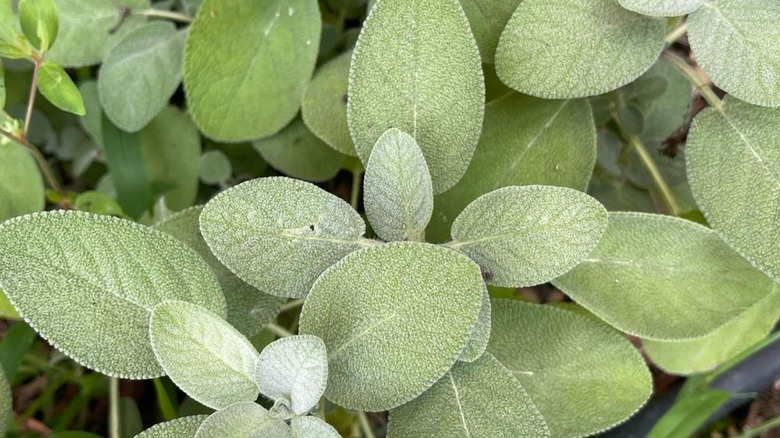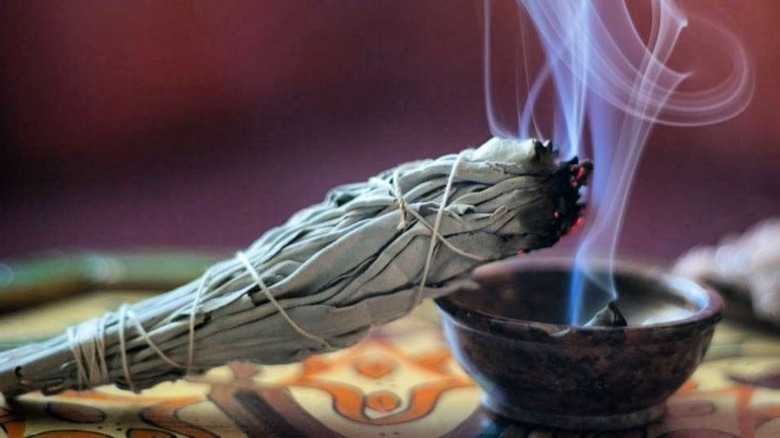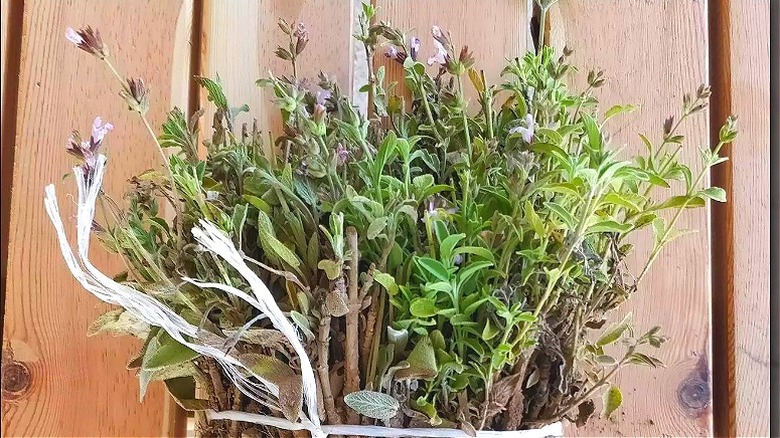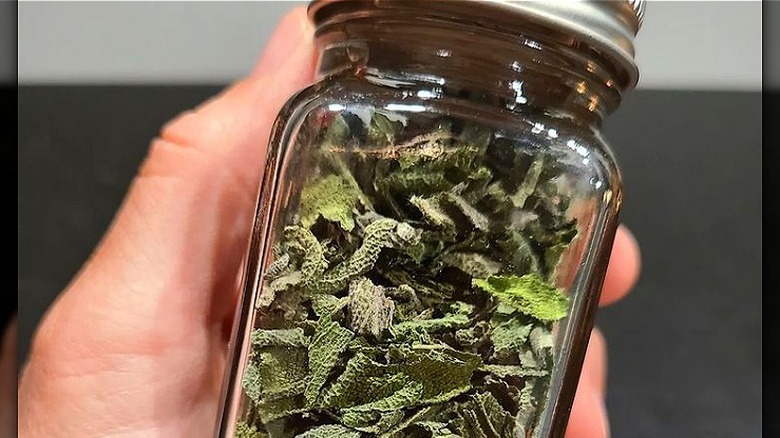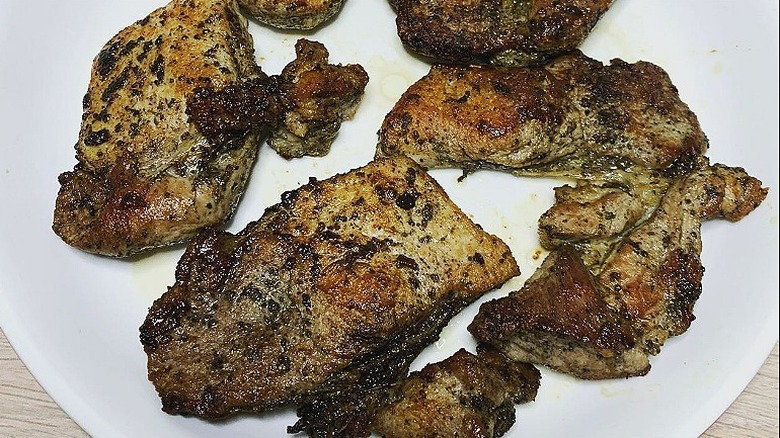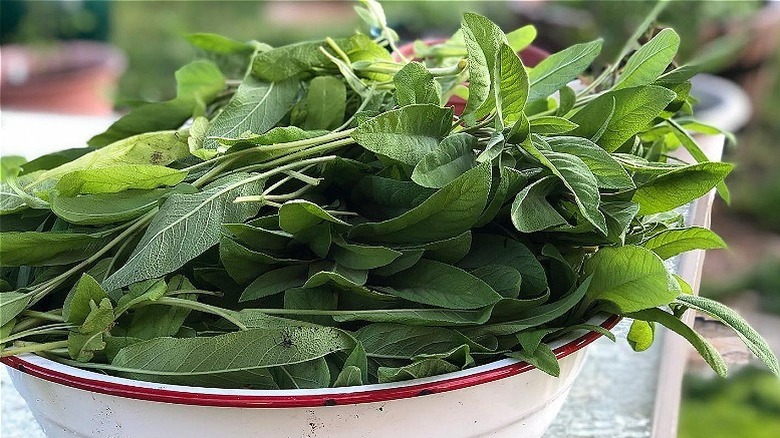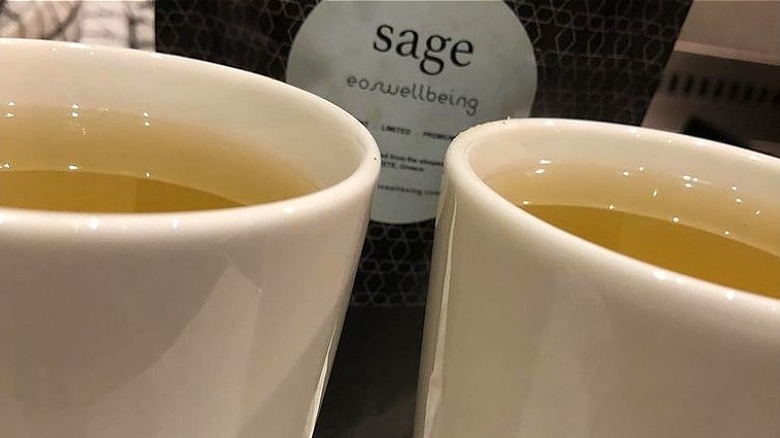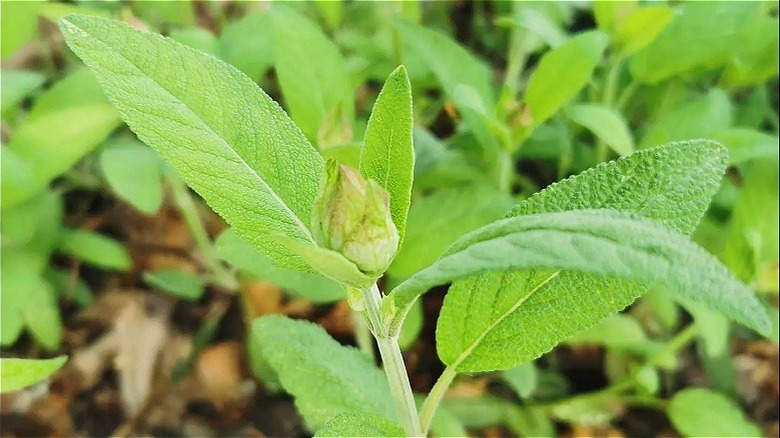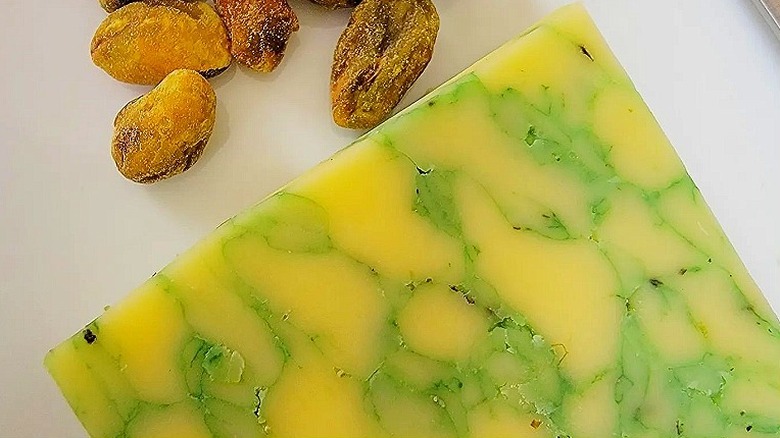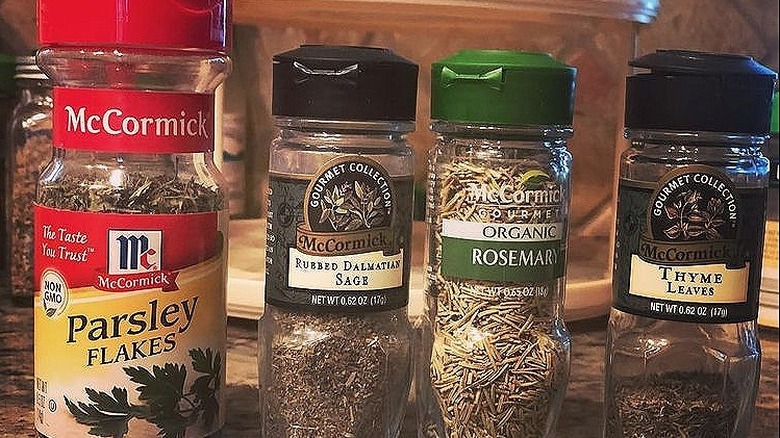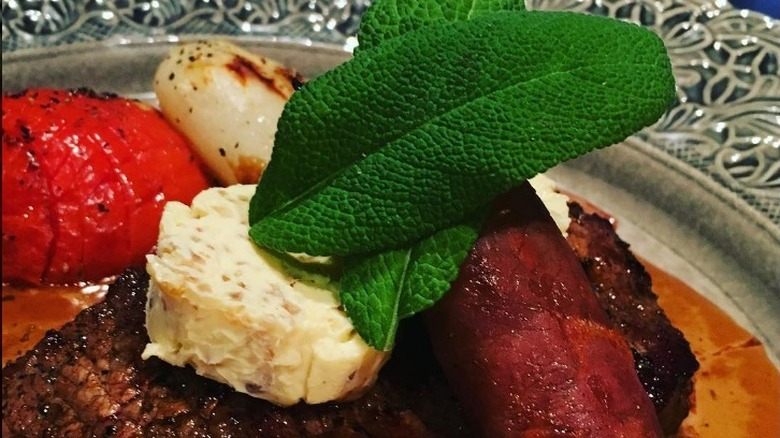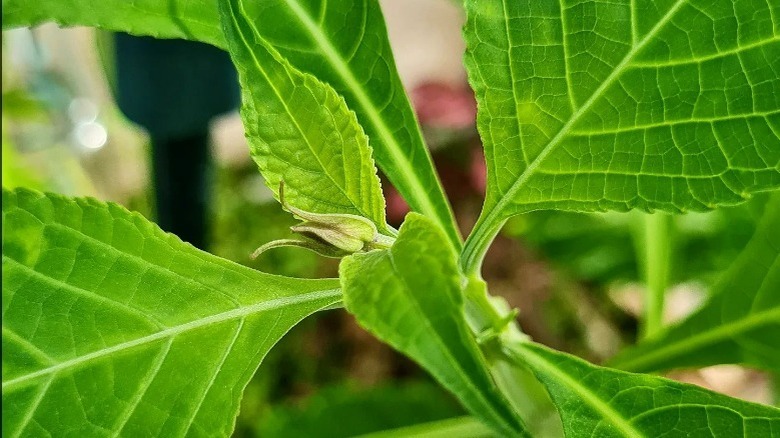The Untold Truth Of Sage
We may receive a commission on purchases made from links.
Sage is a long-standing and often-used herb that holds historical, spiritual, and culinary significance. Sage is a perennial herb that belongs to the mint family, and much like mint, it has a pronounced, almost overwhelming scent and flavor. Yet, unlike mint, sage tastes far more earthy and has flavors similar to citrus and pine.
It's this deep lingering sensory taste that has made sage a popular herb. Green sage leaves, whether they're cooked or crushed, tend to emanate an anxiety-soothing scent that's considered as having medicinal properties. As a cooking herb, sage is often used to enrich the flavors of soups, vegetables, and meats and to make them smell more homey and enriching.
There are 900 different varieties of sage that are cultivated and harvested across the world for a variety of uses and benefits. Sage is a beloved herb that has several different uses. It is used both within the kitchen and beyond. Sage is such an important part of culture that it has a permanent place in an old English folk song that later became a classic hit by Simon & Garfunkel.
Sage was a popular medicine in Medieval Times
The 8th-century Roman emperor Charlemagne was a big fan of herbs and he actively encouraged the farming of various herbs such as fennel, fenugreek, thyme, parsley, coriander, and sage (via The Biomedical Scientist). At the time, sage was widely used for its medicinal properties. When the plague affected Europe, sage was used as an ingredient in one of the treatments used to ease the symptoms of the ailment.
At a time when sickness was viewed as a form of divine judgment and punishment for one's sin, Charlemagne would decree that churches and monasteries would also serve as hospitals to tend to the sick. Some of these monasteries often had herb gardens that likely grew sage.
Though medical science from the Middle Ages was mistakenly focused on curing one's "humors," it was quite apt in its use of sage. In particular, a blend of sage tea combined with honey and vinegar was used as a kind of medieval mouthwash. This potent concoction was quite effective at fighting tooth infections that had long affected the people of Europe.
Sage oil can be used for aromatherapy
The uses and potential of sage as a natural medicine continue to be studied. Some aromatherapy studies have found that the deep and powerful scent of sage-infused oil helps reduce stress and depression as well as lessen the intensity of menstrual cramps.
Sage-infused oil, soaps, and creams are readily available, and growing a sage plant at home can also have a similar aromatic effect. Sage aromatherapy can be used in the reduction and alleviation of different mental and physical symptoms. While these remedies may be helpful, it's important to remember that natural alternative remedies cannot take the place of professional medical diagnosis, treatment, and medicine.
The burning of sage is a long-standing tradition in religious and spiritual practices, most notably in Native American rituals. The act of "smudging," or the ritualistic burning of white sage, has gained popularity in the commercial yoga and "New Age," market. However, this commercialization is problematic due to issues of cultural appropriation.
The popularity of smudging is based on the false idea that burning sage smoke kills airborne viruses such as Covid-19. An article by Well And Good that previously instructed people on the practice of smudging was later updated to express why the practice harms Native American communities and their long-standing traditions. In short, if you're looking for aromatherapy, it's best to stick with sage oil.
It promotes good health
Sage has numerous health benefits. It contains acidic compounds that operate as antioxidants in the body. Antioxidants are beneficial for helping your cells defend themselves against free radicals. Sage contains a whopping 160 polyphenols, which are plant-based antioxidants. Foods high in antioxidants have been linked to a lowered risk of certain cancers and diabetes.
According to Express UK, a study has found that sage also notably decreases LDL cholesterol, which is the type of "bad," cholesterol that can clog your arteries and lead to heart disease. The study found a 19% drop in cholesterol markers in participants who consistently took a 500-milligram sage supplement over a two-month period. Sage was also found to increase HDL or "good" cholesterol in the body in addition to lowering LDL cholesterol levels.
Sage may also be beneficial for improving memory and brain function. Additionally, it is an effective treatment for gum disease.
Fresh and dried versions of sage are available
While fresh sage and dried sage are different forms that originate from the same plant, there are some crucial differences between the two. It may sound like the fresh herb is automatically better than the dried version; however, the two suit different specific circumstances and uses. According to SPICEography, minced fresh sage is ideal for Italian cooking. In Italian dishes, sage is often generously mixed with butter sauces for vegetable or pasta dishes. Yet, dried fresh sage is perfect for roast poultry dishes such as a Thanksgiving turkey. Sage is often rubbed into poultry before baking.
There are two forms of dried sage: Rubbed sage and ground sage. Rubbed sage is composed of dried flakes, similar to dried parsley while ground sage is powdered down to a fine consistency. Fresh sage does provide fresh flavor; however, it has a limited shelf life as it can only last for up to a week. Dried sage, on the other hand, can be stored in a cool, dark place for up to at least six months.
It's ideal for meat
While the earthy tones of sage make it ideal for potatoes and root vegetables, the taste of sage really takes on a whole new level when it is paired with meat. According to SPICEography, sage contains bitter notes of pine and citrus that make it the perfect accompaniment to fattier meats such as lamb as well as different cuts of pork and fatty poultry like duck or goose.
Sage brings some much-needed flavor to meat dishes. Additionally, since the herb is also known for its digestive qualities, it pairs well with delicious yet rich, high-fat meals. Poultry is especially ideal for sage. In fact, sage might just be your go-to ingredient when preparing a whole roast chicken. Additionally, creating a sage-based stuffing for your bird with minced fresh sage can transform your entire dish by giving it the fragrance and taste that it needs. When it comes to cooking meat, sage is a staple alongside ingredients such as salt, pepper, oil, and garlic.
It makes everything smell (and taste) great
Sometimes, there's nothing like the scent of a pot of soup on the stove. Soups and stews are particularly appealing during the cooler months of the fall season and sage is one of those aromatic herbs that enriches these dishes in terms of both flavor and aroma. An article in the Chicago Tribune had nothing but praise for sage, stating that the herb can easily be added to stuffing, making it an easy yet very effective addition to Thanksgiving recipes.
Aroma is a major part of taste. It's why we tend to get a little hungry and impatient at the scent of a herb-roasted turkey with stuffing. According to Robinson Love Plants, sage perfectly appeals to our sense of smell to stimulate our appetite. Not surprising, considering that the smell of sage can help us relax and oftentimes also remind us that we're actually a tad bit on the peckish side.
Sage can be brewed into a medicinal tea
Sage can be used to make a potent tea that carries a host of medicinal benefits. While sage tea leaves are available for purchase, this tea can also just as easily be made at home. To make sage tea, simply pour one cup of boiling water over 1 tablespoon of sage leaves and steep for at least five minutes to reach the proper potency before straining. This beverage may taste a little too strong but it pairs well with sweeteners like sugar and honey as well as other tea additives such as lemon zest and cinnamon.
In addition to antioxidants, sage is also packed with vitamins such as magnesium, zinc, iron, and vitamin K. According to Healthline, vitamin K is an essential body nutrient that contributes to healthier bones and prevents blood clots. Sage also contains a high dose of anti-inflammatories, and can also serve as an at-home remedy for mouth wounds and sore throats.
You can grow sage at home
Sage is a perennial shrub that grows along the shores of the Northern Mediterranean. Culinary sage, also known as common or garden sage, can be grown at home under the right conditions. To grow sage directly from the ground, the seeds should be planted during the late frost months. If you plan to plant sage indoors, this should be done at least six to eight weeks before winter kicks in.
Although sage is a hearty plant that can weather drought or poor soil conditions, well-drained soil, as well as consistent watering of the plant, will yield a healthier and more bountiful bush. Sage takes about 75 days to be ready for harvest. During sage's growing season, make sure you occasionally prune your sage plant in the Spring to allow your healthy plants to grow into strong-smelling leaves. When harvesting, make sure you only pick half the leaves or less.
Although it's the green leaves that are harvested, the sage plant also renders purple flowers that bloom in the summer. These sage flowers look great and make a wonderful addition to any backyard. They're also popular with honey bees, butterflies, and hummingbirds.
There's a type of English cheese that is infused with sage
Sage Derby is a form of cow's milk cheese that originates from the Derbyshire region of England. Sage Derby is among England's most incredible types of cheese; however, it can be difficult to find since it's typically served around the English Thanksgiving harvest festival or during the Christmas season. Sage Derby is made from a combination of salted Derby curd layered with fresh sage that is left to mature for about six months.
It's made through a combination of salted Derby curd layered with fresh sage and left to reach maturity at around 6 months. This cheese has a marbled look with bright green sage that fills the crevices within and around the cheese. The sage in this cheese is wonderfully fragrant without overpowering the overall flavor. The sage pairs well with the Derby cheese and gives it a subtle, yet aromatic flavor. Some methods of making this cheese also infuse sage into the rind, which is the outer layer that forms on the cheese as it matures.
It pairs well with some other herbs and spices
Recipes that use sage also often include other herbs and spices. Open any recipe book or jump onto a cooking website and you'll find at least a few if not several dishes that use herbs and spices used in varying combinations. Sage is commonly combined with thyme, lemon, and ginger. Sage works wonderfully well with ingredients such as apples, meat, and pasta. Even though sage has a powerful flavor on its own, it also plays well with other condiments and ingredients.
According to House Of Knives, and staying true to the tune of "Scarborough Fair," sage pairs well with parsley, rosemary, and thyme. Sage also mixes well with members of its own family tree such as mint. Additionally, sage wonderfully complements Italian dishes that contain oregano. According to a spice pairing spreadsheet from Penn State, sage works well with bay leaves, caraway seeds, ginger, and even paprika.
Sage has several culinary uses
Sage is highly versatile and can be used in numerous different dishes. According to The Pioneer Woman, fresh sage can be used in different sauces and marinades that can be used with different meats and vegetables. The recipe for brown butter sage sauce entails frying butter in a pan until it finally reaches the consistency of the desirable and nutty consistency and then adding several fresh sage leaves and frying them for at least a minute. The result is a buttery sage sauce that is delicious atop a mound of potatoes or pasta.
Softened butter and sage can also be whipped together with other flavors like garlic or red pepper flakes to make a type of compound butter. This type of butter goes very well with dinner rolls and it can even be melted down and used to grill steak. Chopped fresh sage can be added to olive oil and other spices to make a marinade that is perfect for a wide variety of meat dishes.
One strain of the sage plant is a hallucinogen
There are hundreds of varieties of sage; of these, one strain acts as a potent hallucinogen. This strain can't be found in the supermarket. Salvia Divinorum, or Diviner's Sage, is used as a natural and recreational drug. Although Diviner's Sage is considered legal, its use has been regulated in some countries and in several U.S. states. As with many hallucinogens in the U.S., research has been conducted to gauge Diviner Sage's ability to help those suffering from mental issues such as depression and PTSD.
While more research needs to be conducted to ascertain the positive and negative aspects of Diviner's Sage, certain websites caution against the use of the drug. In addition to the side effects of visual distortions, hallucinations, and dizziness, several report dysphoria after use, which is a strong feeling of dissatisfaction or uneasiness that can be quite unpleasant.
